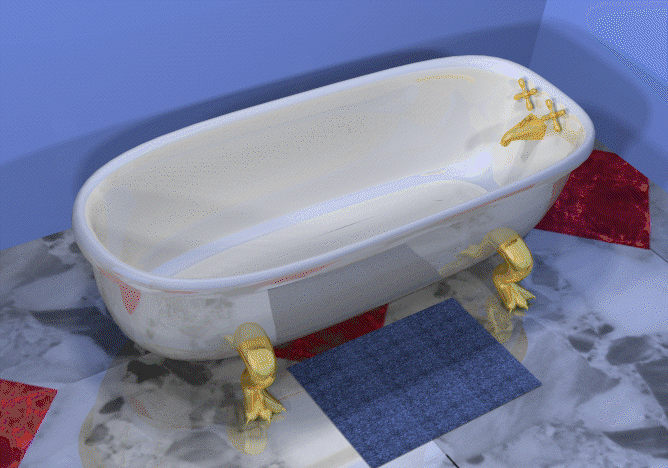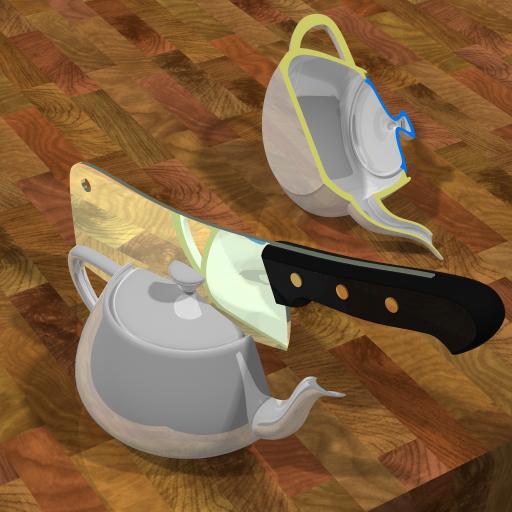 Alpha_1 Model Repository
Alpha_1 Model Repository Alpha_1 Model Repository
Alpha_1 Model Repository
The Utah Teapot is a well-known Computer Graphics icon. It was even used as the symbol of SigGraph '89 in Boston.
The way I got the story (this was even before my time as a grad student at Utah) the original teapot was modeled by Martin Newell and rendered by Jim Blinn in 1974 or early 1975. The Utah Teapot was the first computer graphics object to be designed and rendered as sculptured surfaces, rather than as a set of polygons. The design program which was used to create it used bicubic Bezier patches as a representation, and used a Tektronix storage tube connected to a DEC PDP-10. Position continuity between Bezier patches was maintained by keeping control points on the edges of adjacent 4 x 4 patch control meshes in the same place. Tangent continuity between patches was maintained by keeping the control mesh links adjoining adjacent edges collinear. I don't know how the radial and bilateral symmetries were maintained.
The original model was passed from researcher to researcher for many years, since design systems that produced good curved surface models were extremely rare in those days, and it made a good benchmark for rendering methods. Frank Crow posted the original Teapot Bezier patch control points to the Net, perhaps sometime around 1986.
The original teapot model had a few problems:
It was very visibly NOT a solid model.
Minor visible parts were left out. There was no bottom to the teapot, nor a rim for the lid to rest on. You could see in through the bottom, or past the edge of the lid, to see that there was no inside, either.
The intersection between the spout and the body of the teapot was left implicit. The spout was modeled to simply penetrate through the body surface, so the hidden-surface portion of the image rendering method covered up the portion of the spout which was inside the body.
It was not round. It was pretty close (within 1% or so), so perhaps this is a quibble. A wheel-thrown teapot would be round, but a moulded teapot like the real one of Martin's which the model represents need not be round. However, the very slightly four-lobed cross-sectional shape of the teapot was as close as a cubic Bezier curve could come to representing a circular cross section, reflecting the inability of non-rational Bezier curves to represent conic sections such as circles.
In 1992, Hank Driskill got the idea to make a modern trimmed-NURBS solid model of the Utah Teapot. This was featured (with the addition of warp nacelles) on his SigGraph Tee-Shirt Contest winning "Utah, the Next Generation" tee-shirts.
Hank's teapot model was done in the Alpha_1 Rlisp-based "shape_edit" geometric modeling language. It started by importing the original Bezier teapot data, but then extracted profile curves from the original control meshes and added interior portions to make closed curves. The srfOfRevolution operator was then used to make a round (rational B-spline) solid body and lid. After making a solid of the spout, the spout and body were combined using the set_op program, and a hole down the middle of the spout subtracted out so the teapot would actually pour if constructed as modeled, say by a rapid prototyping machine.
I started with Hank's model, converted it to SCL, the C++ shape_edit language, and tweaked it up a bit to refine the insides he added. I came up with a more aesthetic approach to making the hole down the middle of the spout, scaling down the outer surface of the spout to make a tapered, contoured hole and using the combineShells operator in c_shape_edit to trim the solids together.
I also modeled and rendered a scene revealing the lovely insides of the teapot by slicing it in half like an onion. (Slightly surrealistic, I admit.)
A cleaver and chopping block complete the scene. The cleaver was modeled after a real Sabatier cleaver we've had for 25 years, which I xeroxed, cut out, taped to my monitor, and drew outline curves around using the Alpha_1 shape3d graphical user interface for c_shape_edit.
The final image, rendered by the Alpha_1 Ray Tracer and printed out in a 2 foot square size on the EnCad printer by Robert McDermott, is on display somewhere in the High-Performance Computing and Networking building on the U of U campus.
 Alpha_1 Model Repository Home Page
Alpha_1 Model Repository Home Page